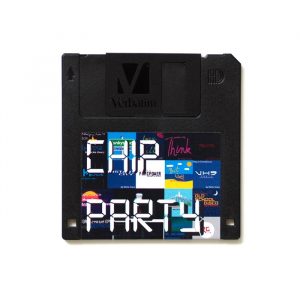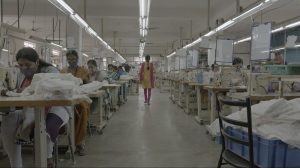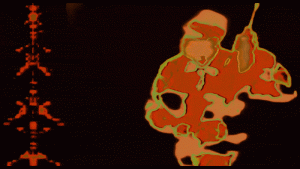 Drew Hemment created the Futuresonic International Festival in 1995. As AHRC Research Fellow at University of Salford, he developed Loca, a collaborative arts-based project on mobile media and surveillance. He is also a founder member of PLAN – The Pervasive and Locative Arts Network.
Drew Hemment created the Futuresonic International Festival in 1995. As AHRC Research Fellow at University of Salford, he developed Loca, a collaborative arts-based project on mobile media and surveillance. He is also a founder member of PLAN – The Pervasive and Locative Arts Network.
Together with José Luis de Vicente and Óscar Abril Ascaso, Drew Hemment curated the SonarMatica exhibition at Sonar this year.
Always On, Always Everywhere
Drew started by telling that, two years ago, he visited the Baja Beach Club, a club that represented the “cutting-edge of locative media.” The Barcelona’s club was the first in the world to use an RFID implant in place of VIP cards. Punters were invited to have the VIP VeriChip (the same kind of chip injected under the skin of pets) injected under their skin. Just by having your arm scanned, you can be recognised as a VIP, skip the queues at the door and pay for your drinks at the end of the night. That was the theory. When Hemment visited the club he found out that the whole story was more of a publicity stunt. Computers were not set up. It looked like a scam. VeriChip has often been associated with rather spectacular and somewhat dubious ideas such as the proposals to have migrants chipped or to tag the bodies of the victims of the hurricane Katrina.
Drew Hemment managed to interview Conrad Chase, the owner of the club (who later became a star of the Gran Hermano, the Spanish version of Big Brother.) The interview is online (i’m still wondering how he managed not to laugh during the interview). Conrad explains that the injection makes people very unique and positions them as trendsetters: “everyone has piercings and tattoos, not very many people have the VIP chip.” Read also the whole story of Drew’s visit at the club: Last night an Arphid saved my life.
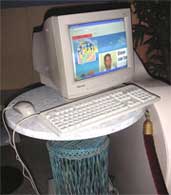
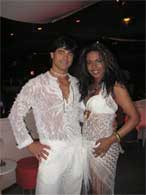 VIP Chip system in action and Conrad Chase + a friend
VIP Chip system in action and Conrad Chase + a friend
In some ways, the Baja Beach Club rfid experiment is the cutting edge of Locative Media: it is not happening in a gallery or a consumer electronics fair but in a night club.
According to Drew Hemment, we’ve arrived at a crucial moment. Locative Media technologies are now breaking out of the hacker gulag. In 2003, the technologies were mostly in the hands of programmers and artists. Some social and art project that were still conceptual a few years ago are now coming into the mainstream. Now the situation is evolving. He gave two examples from the UK: mobile phone operator O2 is now offering Streetmap. What was being discussed and done in small workshop (e.g. PLAN) is now developed on large scale and polished by a major mobile phone operator. The other example is satellite navigation: it was the must have item last christmas. Google Earth is now a concept that most people grasp.
It’s important to be able to engage in this and we shouldn’t leave the whole development in the sole hands of the people who want to make money out of these technologies.
Hemment then gave the example of a group of German activists: FoeBuD. A MIT study has revealed that the Germans were the most naturally resistant to the massive implementation of RFID.
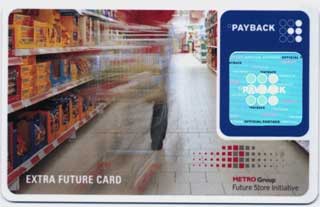
FoeBuD recently took the industry wrong-footed. The supermarket chain Metro set up the Future Store in Rheinberg to showcase how new technologies can re-shape the “shopping experience.” They were offering shoppers cards that looked like normal loyalty cards but contained RFID chips. Without telling the customers about the presence of the chip. FoeBuD found out about it and wrote the supermarket chain who stepped back and added on the card a mention of the presence of the chip inside the card. FoeBuD had taken picture of the card before and after and issued a press release asking if customers could really trust a company that had lied to them. In Germany, there’s thus a more mature debate that doesn’t exist in other countries.
How can we respond to the technology? By showing different uses of it, by learning its limits and pushing them, by adding to the debate, etc. Being afraid of a technology is probably as bad as not knowing about it. We should try to embed social values into the RFID technology. The technology is still young, which leaves us with a small window of opportunities to get on, influence and propose alternative uses that were not foreseen right from the start. An example of something similar: Acid House: old technology used for something else. If we wait too long, some possibilites will be closed, others will be lost.
During Futuresonic, an international conference will explore the implications of RFID on July 21-22 in Manchester UK.
Images from the Barcelona club courtesy of Drew Hemment.

